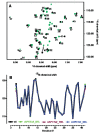Cyclisation increases the stability of the sea anemone peptide APETx2 but decreases its activity at acid-sensing ion channel 3
- PMID: 22851922
- PMCID: PMC3407927
- DOI: 10.3390/md10071511
Cyclisation increases the stability of the sea anemone peptide APETx2 but decreases its activity at acid-sensing ion channel 3
Abstract
APETx2 is a peptide isolated from the sea anemone Anthopleura elegantissima. It is the most potent and selective inhibitor of acid-sensing ion channel 3 (ASIC3) and it is currently in preclinical studies as a novel analgesic for the treatment of chronic inflammatory pain. As a peptide it faces many challenges in the drug development process, including the potential lack of stability often associated with therapeutic peptides. In this study we determined the susceptibility of wild-type APETx2 to trypsin and pepsin and tested the applicability of backbone cyclisation as a strategy to improve its resistance to enzymatic degradation. Cyclisation with either a six-, seven- or eight-residue linker vastly improved the protease resistance of APETx2 but substantially decreased its potency against ASIC3. This suggests that either the N- or C-terminus of APETx2 is involved in its interaction with the channel, which we confirmed by making N- and C-terminal truncations. Truncation of either terminus, but especially the N-terminus, has detrimental effects on the ability of APETx2 to inhibit ASIC3. The current work indicates that cyclisation is unlikely to be a suitable strategy for stabilising APETx2, unless linkers can be engineered that do not interfere with binding to ASIC3.
Keywords: APETx2; ASIC3; cyclisation; peptide; sea anemone; stability; truncation.
Figures






References
-
- Lax R. The Future of Peptide Development in the Pharmaceutical Industry. PharManufacturing: The International Peptide Review. 2010 Sep:10–15.
-
- Thayer A.M. Improving peptides. Chem. Eng. News. 2011;89:13–20.
-
- Chiras D.D. Human Biology. 7th. Jones & Bartlett Learning; Mississanga, Canada: 2011. Nutrition and digestion; pp. 89–117.
Publication types
MeSH terms
Substances
LinkOut - more resources
Full Text Sources
Other Literature Sources
Research Materials

